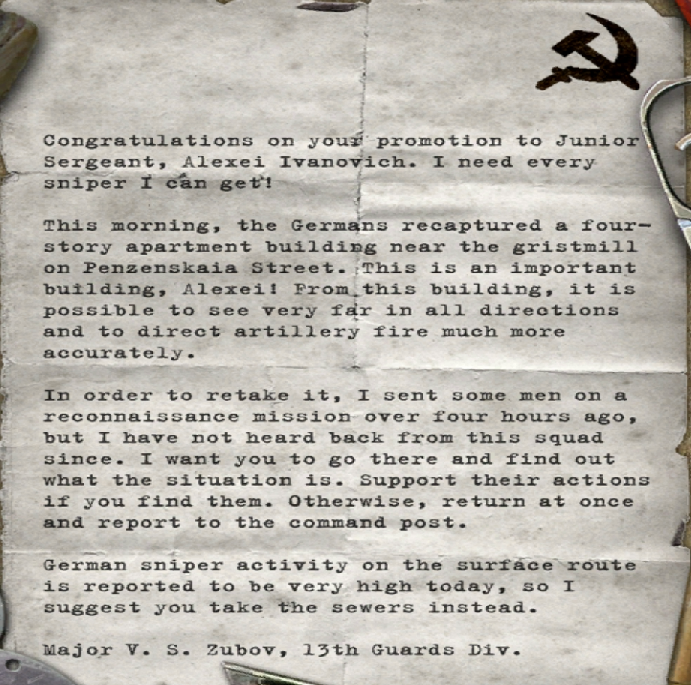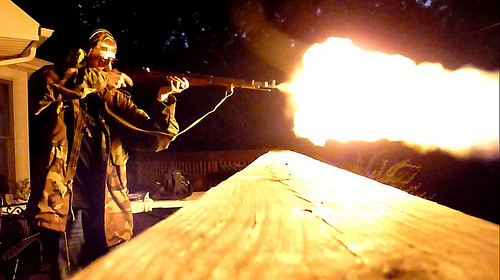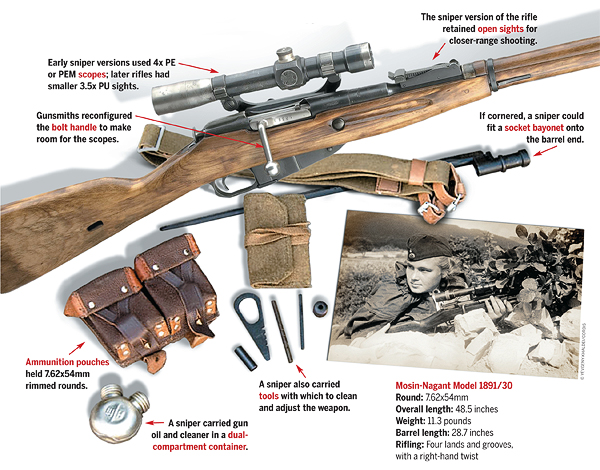Part 9: Pavlov's House

Episode 9: Pavlov's House: Youtube, Polsy
Shadowed Bacon posted:
Here's that info I promised, was just waiting for an update.
Russian guns so far:
Mosin-Nagant (A.K.A Mosin-Nagant 91/30, Mosin rifle, 3-line rifle- Model 1891/30)
The Mosin-Nagant 91/30 was Russia's bolt action rifle for World War 2. It hold 5 rounds of 7.62 x54R rifle cartridges. are loaded by hand or by “stripper clip”. It's is noted as rugged and reliable, but other than that it's unremarkable in function, other than a “safety” that is considered useless due to the difficulty in engaging it (that “nob” at the end of the bolt assembly? If you pull it back and twist the long slip of metal over a flat part of the receiver, you make the gun “safe”. It's much harder than it sounds, and you're better off just not chambering a round in the first place). It is also the longest infantry rifle of WW2. It uses a removable spike bayonet.
The design was born out of the necessity of Russia needing a faster firing rifle to counter newer designs, specifically the Winchesters the Turks used in the Russo-Ottoman war. The resulting cluster fuck of bureaucracy between Captain Sergei Ivanovich Mosin, Leon Nagant, and the military council choosing the design resulted in a mash-up design of the best features of the two leading designs. This first model is called the M91. Due to shortages during WW1, Russia ordered over 3 million rifle from American manufacturers, such as Remington and New England Westinghouse. About half a million rifle were shipped before the Russian revolution, and the rest of the manufactured rifles (about 300K rifles) where bought by the US military. After the revolution, the rifle was updated, the front sight was given a hood ( the loop of metal around the sight itself) to prevent the sight being knocked out of alignment, and the barrel shortened, and the distance measurements where changed from Arshins to Meters. This is the M91/30 variant and the most common rifle used during WW2. It should be noted the updates were inspired by the earlier “dragoon” variant of the rifle.
Common variants:
M38/M44: a shortened “carbine” version of the rifle, the M44 has a side-folding bayonet
M/28-30 : a Finnish version used by Simo Häyhä (if you have no idea who that it, read up on him!)
Type 53: a Chinese copy of the m44. Insert your knockoff joke here
Obrez: unofficial name of rifles “sawed off” and converted to bolt-action pistols, used as assassination tools during the revolution. Once Nagant revolvers became more common, Obrez became less common
currently the rifle has been supplanted by much more accurate rifles, as is now considered a cheap “clunker” rifle that people can modify without fear of wasting too much money (think off those people that trick out shitty cars).
Mosin Fireball!
Mosin Snipers
Mosin-Nagant 91/30's that had exceptional accuracy were given 3.5x PU Scope (earlier, they where given a 4x Zeiss copy known as PE or PEM) and a curved bolt handle. Unlike most sniper rifles, the scopes were placed so high on the rifle, the front sights could still be used (the model in-game seems to be missing it's front sight for some reason). Numerous snipers became famous using this rifle, as noted here:
http://www.snipercentral.com/snipers.htm
Note the massive number of Russian on the WW2 list, as well as how close the top Russian came to Simo's record (500 vs. 542).
I should note the game depicts the gun being loaded by “stripper clip” like its unscoped version, this is not possible, or at least not a good idea as it would might mess with scope alignment. There is a “civil guard” sniper stripper clip, but that is rare.
PPSh-41 (A.K.A Papa Shaw)
before the PPSh-41, the only sub-gun the Russians had was the PPD-40, which was to complicated for mass production. Sub-guns, like the MP-40 or the Tommy, are used for close quarters combat like those found in cities
Early guns were given 72-round drums, but they suffered the same problems as the Tommy drums (difficult to fill, heavy etc.) so a 35-round curved box magazine was introduced. Most boxes of ammo comes in 72. It should be noted the game only gives you 71 rounds, this is most likely because loading to full capacity could increase the chance of gun jam/mag failure in some guns.
Here is some info straight from Wikipedia:
Wikipedia posted:
Barrel production was often simplified by using barrels produced for the 7.62mm M1891 Mosin–Nagant rifle: the rifle barrel was cut in half, and two PPSh barrels were made from it after machining the chamber for the 7.62mm Soviet submachine gun cartridge.
After the German Army captured large numbers of the PPSh-41 during World War II, a program was instituted to convert the weapon to the standard German submachine gun cartridge - 9mm Parabellum. The Wehrmacht officially adopted the converted PPSh-41 as the MP41(r); unconverted PPSh-41s were designated MP717(r) and supplied with 7.63x25mm Mauser ammunition (which is dimensionally identical to 7.62x25mm, but somewhat less powerful). German-language manuals for the use of captured PPShs were printed and distributed in the Wehrmacht.
The PPS, an even simpler submachine gun, was introduced in Soviet service, although it did not replace the PPSh-41 during the war.
The Soviet Union also experimented with the PPSh-41 in a close air support anti-personnel role, mounting dozens of the submachine guns in forward fuselage racks on the Tu-2sh variant of the Tupolev Tu-2 bomber.
Over 6 million PPSh submachine guns were produced by the end of the war. The Soviets would often equip whole regiments and even entire divisions with the weapon, giving them unmatched short-range firepower. Thousands more were dropped behind enemy lines to equip large partisan formations to disrupt German supply lines and communications.
The gun uses the 7.62×25mm Tokarev pistol round.
variants:
PPS-42 or 43: technically a different gun, it was an all metal design using steel stamping, like the mp-40.
It delivered the same firepower, with less skilled labor and man-hours to produce, and at a lower weight.

